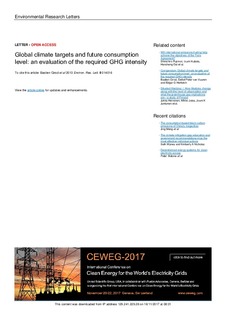| dc.contributor.author | Girod, B | |
| dc.contributor.author | van Vuuren, DP | |
| dc.contributor.author | Hertwich, Edgar G. | |
| dc.date.accessioned | 2017-11-17T11:07:42Z | |
| dc.date.available | 2017-11-17T11:07:42Z | |
| dc.date.created | 2013-06-17T09:45:24Z | |
| dc.date.issued | 2013 | |
| dc.identifier.citation | Environmental Research Letters. 2013, 8 (1), . | nb_NO |
| dc.identifier.issn | 1748-9326 | |
| dc.identifier.uri | http://hdl.handle.net/11250/2466882 | |
| dc.description.abstract | Discussion and analysis on international climate policy often focuses on the rather abstract level of total national and regional greenhouse gas (GHG) emissions. At some point, however, emission reductions need to be translated to consumption level. In this article, we evaluate the implications of the strictest IPCC representative concentration pathway for key consumption categories (food, travel, shelter, goods, services). We use IPAT style identities to account for possible growth in global consumption levels and indicate the required change in GHG emission intensity for each category (i.e. GHG emission per calorie, person kilometer, square meter, kilogram, US dollar). The proposed concept provides guidance for product developers, consumers and policymakers. To reach the 2 °C climate target (2.1 tCO2-eq. per capita in 2050), the GHG emission intensity of consumption has to be reduced by a factor of 5 in 2050. The climate targets on consumption level allow discussion of the feasibility of this climate target at product and consumption level. In most consumption categories products in line with this climate target are available. For animal food and air travel, reaching the GHG intensity targets with product modifications alone will be challenging and therefore structural changes in consumption patterns might be needed. The concept opens up possibilities for further research on potential solutions on the consumption and product level to global climate mitigation. | nb_NO |
| dc.language.iso | eng | nb_NO |
| dc.publisher | IOP Publishing | nb_NO |
| dc.rights | Navngivelse-Ikkekommersiell-DelPåSammeVilkår 4.0 Internasjonal | * |
| dc.rights.uri | http://creativecommons.org/licenses/by-nc-sa/4.0/deed.no | * |
| dc.title | Global climate targets and future consumption level: an evaluation of the required GHG intensity | nb_NO |
| dc.type | Journal article | nb_NO |
| dc.type | Peer reviewed | nb_NO |
| dc.description.version | publishedVersion | nb_NO |
| dc.source.pagenumber | 10 | nb_NO |
| dc.source.volume | 8 | nb_NO |
| dc.source.journal | Environmental Research Letters | nb_NO |
| dc.source.issue | 1 | nb_NO |
| dc.identifier.doi | 10.1088/1748-9326/8/1/014016 | |
| dc.identifier.cristin | 1034548 | |
| dc.relation.project | Norges forskningsråd: 206998 | nb_NO |
| dc.relation.project | Norges forskningsråd: 209697 | nb_NO |
| dc.description.localcode | Content from this work may be used under the terms of the Creative Commons Attribution-NonCommercial-ShareAlike 3.0 licence. Any further distribution of this work must maintain attribution to the author(s) and the title of the work, journal citation and DOI. | nb_NO |
| cristin.unitcode | 194,64,25,0 | |
| cristin.unitname | Institutt for energi- og prosessteknikk | |
| cristin.ispublished | true | |
| cristin.fulltext | original | |
| cristin.qualitycode | 1 | |

